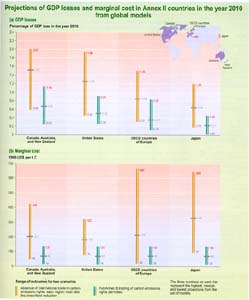Bottom-up studies indicate that substantial low-cost
mitigation opportunities exist. According to bottom-up assessments
(see Box 7-1) of specific
technologies and sectors, half of the potential emissions reductions
noted in Table 7-1 may be
achieved by the year 2020 with direct benefits exceeding direct costs,
and the other half at a net direct cost of up to US$100 per t Ceq
(at 1998 prices). However, for reasons described below, the realized
potential may be different. These cost estimates are derived using discount
rates in the range of 5 to 12%, consistent with public-sector discount
rates. Private internal rates of return vary greatly, and are often
significantly higher, affecting the rate of adoption of these technologies
by private entities. Depending on the emissions scenario, this could
allow global emissions to be reduced below year 2000 levels in the period
2010-2020 at these net direct costs. Realizing these reductions
involves additional implementation costs, which in some cases may be
substantial, the possible need for supporting policies, increased R&D,
effective technology transfer, and overcoming other barriers. The various
global, regional, national, sector, and project studies assessed in
the WGIII TAR have different scopes and assumptions. Studies do not
exist for every sector and region.
The models used in the above study show that the Kyoto mechanisms are important in controlling risks of high costs in given countries, and thus could complement domestic policy mechanisms, and could minimize risks of inequitable international impacts. For example, the brown and blue lines in Figure 7-2b and Table 7-3b show that the national marginal costs to meet the Kyoto targets range from about US$20 up to US$600 per t C without Annex B trading, and range from about US$15 up to US$150 per t C with Annex B trading, respectively. At the time of these studies, most models did not include sinks, non-CO2 greenhouse gases, CDM, negative cost options, ancillary benefits, or targeted revenue recycling, which will reduce estimated costs. On the other hand, these models make assumptions which underestimate costs because they assume full use of emissions trading without transaction costs, both within and among Annex B countries, and that mitigation responses would be perfectly efficient and that economies begin to adjust to the need to meet Kyoto targets between the years 1990 and 2000. The cost reductions from Annex B trading will depend on the details of implementation, including the compatibility of domestic and international mechanisms, constraints, and transaction costs. The following is indicative of the broad variation in the change in GDP reported for Annex B countries:
-
For Annex II countries, the above modeling studies show reductions in GDP, compared to projected levels in the year 2010. Figure 7-2 indicates that in the absence of Annex B trading losses range from 0.2 to 2% of GDP. With Annex B trading, losses range from 0.1 to 1% of GDP. National studies, which explore a more diverse set of policy packages and take account of specific national circumstances, vary even more widely.
-
For most economies in transition, GDP effects range from negligible to a several percent increase, reflecting opportunities for energy-efficiency improvements not available to Annex II countries. Under assumptions of drastic energy-efficiency improvement and/or continuing economic recessions in some countries, the assigned amounts may exceed projected emissions in the first commitment period. In this case, models show increased GDP due to revenues from trading assigned amounts. However, for some economies in transition, implementing the Kyoto Protocol will have similar impact on GDP as for Annex II countries.
 |